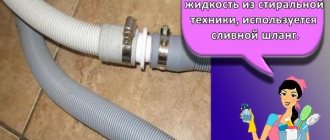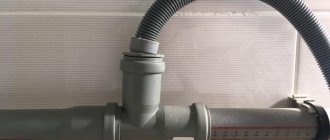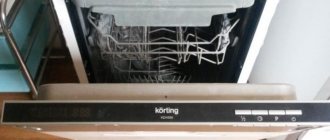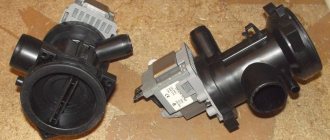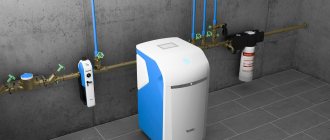A dishwasher is a real salvation for female housewives. After all, thanks to this device, you no longer have to wash the dishes yourself. To do this, just put it in the loading compartment and wait a while. It's simple.
But it is only at first glance that the dishwasher looks like a simple device. A lot of different mechanisms are used inside it to ensure uninterrupted operation for many years. If one of these mechanisms fails, then all operation of the machine stops until the dishwasher is repaired. One such device is a plastic dishwasher inlet hose.
In the operation of a dishwasher, the hose plays the most important role - it supplies cold or hot water inside the loading compartment. If water is not supplied inside, then the dishes are not washed. Therefore, it is very important to diagnose the causes of hose failure in a timely manner, and then eliminate them.
Types of hoses
In addition to the inlet hose, the dishwasher also has a drain hose. It performs the function of draining dirty water after completing the dishwashing cycle. Its safety also plays a very important role, since many factors will depend on this (working speed, presence of unpleasant odor, etc.).
The inlet hose, in particular, has a special design that protects the machine from sudden leaks. This device is called a hose with an “aquastop” device for a dishwasher. It is thanks to such a hose that you can not be afraid of a sudden break in the water supply network. A special mechanism is able to prevent water leakage in the dishwasher in time, after which you can begin to eliminate problems with breakage.
If desired, such a hose can be installed in place of the drain, thereby increasing the safety of the system several times. But before this, it is recommended to install special barrier filters that will prevent the hose from clogging with debris. In addition, it will extend the life of the dishwasher.
Hoses can also be divided by material of manufacture. The most common option is plastic hoses. After all, they are not only practical, but also distinguished by their low cost. This makes it easy to replace the hose whenever necessary.
In addition to plastic, rubber hoses with a metal braid are used. These hoses are distinguished by their durability and ease of installation. They are quite difficult to damage, which gives them some advantage. They are used as fillers.
Replacement
The processes of dismantling and subsequent installation of the described structural elements of modern dishwashers themselves do not require significant time expenditure or special skills. Before starting any work you must:
In addition to all of the above, you need to purchase new hoses of the appropriate length. This parameter is determined taking into account the height and other dimensions of the PSM, as well as its location.
The inlet hoses responsible for supplying water to the washing chamber can be connected to both cold and hot water supply. Naturally, the type of hose and its features will be determined by the brand and model of a particular dishwasher. The situation is similar with the connection method. In the vast majority of cases, the inlet hose is connected to the bottom of the rear panel of the device. Replacing it itself is a simple procedure: quite carefully unscrew the nut and remove the old element, then install the new one and secure it.
For some PSM models, the water supply line runs inside the housing. In such cases, the task is slightly complicated due to the need to partially disassemble the equipment. The process involves performing the following actions:
The next important point is how to properly replace the drain hose. Please note that this drain hose is connected to the dishwasher from below.
Depending on the design features of the model, the connection point may be on the left or right side. Replacing a sleeve with your own hands is the simplest procedure possible. However, before starting it, it is recommended to establish the reason why the hose has ceased to perform its functions.
It is often quite simple to clean the flexible piping. But in both cases, the algorithm of actions will consist of 7 steps.
At the final stage, all that remains is to connect the new element. Naturally, all of the above steps must be performed in reverse order. Also, do not forget about the need to test the replaced hose.
Choosing the Right Hose for Your Dishwasher
In order to decide on the choice of a high-quality dishwasher hose, you need to take into account some points. Such as:
- machine performance characteristics
- hose length
- hose material
- financial budget for the purchase of a hose.
It’s worth starting with the operating characteristics of the dishwasher, since it is necessary to achieve maximum matching of the capabilities of the hose with its operating result. For example, if the machine consumes up to 5 liters per minute, then you can choose a less durable hose. If water consumption is more than 5 liters per minute, then a higher quality hose will be required.
The length of the hose also plays a very important role. If the hose is very short, this can become a very significant obstacle to ensuring the high-quality operation of the device. You shouldn't take a very long one. This will create additional interference when pumping water.
Important! The hose must be selected with some reserve. If the water source is about 1 m long, then it is worth purchasing a hose 1.10 m long.
The material, as mentioned above, also plays a very important role. The main materials are plastic and rubber. Depending on the allocated financial capabilities, it is worth choosing one or another material.
The main problems in the operation of the hose
The most common problem with a hose is its external or internal damage. Over time, any material becomes less resistant to pressure and constant friction of water, thereby causing the hose to fail.
Another reason may be clogging of the internal space. Water in urban water supply conditions often has very low quality indicators. This means that it contains impurities of heavy metals, dirt and other small particles, which over time clog the pipe. In most cases, this has little effect on the operation of the machine, but over time it can cause damage to its internal parts.
Don’t forget about the careless attitude of people during installation. If the inlet hose with aquastop was installed incorrectly during installation, then sooner or later this will affect its operation and error E15 will appear. For example, at the most unfortunate moment, the hose can be knocked out of the fitting, thereby flooding the neighbors below. Don’t forget about this, and it’s better to be on the safe side.
Hose diagnostics
It is very important to thoroughly diagnose the condition of the hose in a timely manner. This should be done at least once a month. It is with this approach that the dishwasher will last a longer period of time.
Diagnostics can be carried out using various devices (like a pressure gauge and the like), but not every city resident has such devices. Therefore, the check should be done using available means.
First, you should assess the condition of the hose visually. If it is in satisfactory condition, then you can check it for leaks. It is better to do this while the machine is running. There are no leaks - the hose is fine.
The presence of blockages can be checked using a plumbing brush or using a regular wire.
How to shorten?
For one objective reason or another, sometimes dishwasher hoses are too long. If we are talking about the water supply line, then the only reasonable solution would be to buy a new hose. Things are much simpler with drainage. It is important to note that a long hose will inevitably get twisted and make it difficult to drain dirty water. That is why it will need to be shortened.
The simplest thing is to trim off the excess piece with a sharp knife. But it is worth remembering that in this case it will not be possible to use a special tip.
This is true if the drain is connected to the sewer system through a kitchen sink siphon or a tee. In such situations, the hose should be shortened using special connectors.
Correct hose installation
For high-quality operation of the machine, it is also extremely important to correctly install the drain and inlet hoses. Depending on how the hoses are installed, the further quality of work during operation will depend.
The inlet hose is much easier to install, since it only requires skills in handling simple tools and some time. The essence of its installation is to connect the hose to the water supply and to the inlet valve on the dishwasher. In this case, special attention must be paid to sealing the connection. Thanks to this, leaks will not form.
Replacing the drain hose on a dishwasher is a little more difficult. For a quality installation, you will need to purchase additional items:
- drain siphon (it will prevent odors from entering the apartment);
- fasteners for attaching the hose;
- drain hose at least 1.5 m long.
To make the process of draining water much faster and without causing blockages, it is necessary to place the hose slightly higher than the connection point in the sewer. Usually this is no more than 60 cm. This can be done using special fastening clamps, screwing them to the wall.
Then you need to make a siphon. It is this that will prevent the unpleasant smell from the dishwasher from entering the apartment. The siphon is also easy to install with a small set of tools, after which it should be carefully sealed with silicone sealants. This will also prevent the smell from getting in.
After installing the siphon, you can connect it to the hose and diagnose the operation. If everything is done correctly, the water will drain quickly and without problems.
dishwasher - in the far corner
As always, after completing a kitchen renovation, the question suddenly arose: where should we squeeze in a dishwasher? The place was found in the corner opposite the sink. This means that to the drain we have 7 meters along the baseboard with one 90 degree turn. A dishwasher pump will not pump this distance. The sololift type pump has clearly excess power and costs as much as another dishwasher. Laying a pipe along the wall at an angle to drain by gravity will also not work. I'm sitting, thinking what to do.
486dx2 wrote: A dishwasher pump will not pump such a distance.
” > Here, for example, they write: It is advisable to install the dishwasher so that the length of its drain hose is no more than one and a half meters. It can be longer than 1.5 m, but then the dishwasher pump will have an additional load, which sometimes leads to early failure. If the rise with the bend of the drain hose does not fit into 1.5 meters of its length (we wrote about how the length of the drain affects the pump of a dishwasher in step No. 3), then it is extended, preferably no more than 3 meters or, at the very least, case, up to 5m.
2486dx2 These figures are based on standard flexible corrugated hoses. Take a pipeline with less dynamic resistance, smooth, and a larger diameter, and plug the drain hose from the PMM into it. Of course, it is necessary to ensure a tight seal that can be maintained under pressure.
With such a pipe length, larger diameter and minimal water consumption with modern machines, all dirty water will remain in the pipe after washing. It turns out that either you need to additionally run the machine at idle speed each time, or connect the inlet hose to the drain hose through an additional tap for regular washing?
2486dx2 What do you think is left in a regular hose?
Lay a 50 mm pipe to the dishwasher (regular sewer) and install a siphon from the sink (make a water seal).
Why raise sinks down the drain? Connect the pipes on the lower level. And from the dishwasher to the pool, run pipes that are as long as possible (so that there are fewer joints) while maintaining a constant slope (2 cm per meter). Afraid of turning 90? Make it in the form of two at 45 or three at 30. Is there also a corner under the kitchen plinth? This means there is room to turn around.
About getting stuck. I think that once every 5 years, as a preventative measure, it will not be difficult to inspect the turn. It takes 10 minutes when using plastic pipes.
And the water that drains out of the machine is not cold, along with detergent, which is intended to dissolve fat. Wrap the entire drain with energyflex, the water in the pipe will cool less, which means there will also be less settling.
Source
Replacing and extending the hose on a dishwasher
Over time, the hose has to be changed. You should not blame the manufacturers, since this process is natural for absolutely all parts of such devices.
To replace the hose, you will need to purchase a new hose of the desired quality and length. It is best to purchase a hose that was previously installed. But you should do this only if you were completely satisfied with the hose’s performance before.
After the hose has been purchased, you just need to put it in its original place. You need to replace all the old rubber bands, treat the mounting area with anti-corrosion repellent, and then check how it works.
Extending the drain hose is also not difficult. To do this, it is necessary to carry out all the necessary measurements of the length to the required object and the diameter of the hose. After that, it is enough to purchase a hose connector of the required length and, with simple manipulations, connect the old hose to the new one.
This way you can grow the hose to very large sizes. The only limitations are the capabilities and needs of a person.
Replacement
How to extend the dishwasher hose? First you will need to measure the distance from the dishwasher to the drain point. Then you should purchase an extension cord of the required length, 25mm in diameter, three clamps and a connecting fitting. Clamps are put on the ends and on the siphon and connected to the fitting.
When replacing a damaged hose, purchase a new one of the required length and clamps with a diameter of 30 mm. First, remove the check valve c. Then the hose itself is unscrewed from the back panel, having first removed 6 screws and removed the sleeve. Next, a new hose and clamp are installed. The two parts of the sleeve are connected and it is inserted into the back panel. The screws are also secured in place.
First run
When the dishwasher is connected to the power supply and the inlet and drain hoses with aquastop are connected, you should “run” the machine for the first time without loading dishes. Thereby check the correct connection of all communications, namely -
The first cycle of turning on the dishwasher is carried out with the presence of all detergents and special detergents. Thus, it will be checked how tightly all joints and bends are connected.
When the dishwasher has been tested at home - the hoses remain intact and do not leak, you can congratulate yourself on the successful connection.
Source
How to clean a dishwasher hose
During operation, many housewives ask the question: how to clean the drain hose? This will most likely require the help of the male half, since you will have to do a little work with tools.
First, you need to completely disconnect the hose from the machine and the water supply network. After this, you can start cleaning the hose using a special brush or simply soak it in a weak alkali solution (you can also use acids). We clean the inner surface in such a way that there is nothing unnecessary left there. This will allow you to quickly remove absolutely all barriers inside the hose. After the manipulations have been completed, you need to return the hose to its place. If nothing has changed after cleaning, the hose should be replaced.
How to lengthen?
Quite often, the standard length of the hoses that come with the PSM is not enough . The way out of such situations is to purchase a longer sleeve or change the parameters of an existing one, which can always be increased. It is important to note that this is relevant for both the filling and draining systems of the machine. In the first and second cases, extension is carried out using a special coupling.
Experienced specialists strongly recommend using brass elements, which compare favorably with their plastic counterparts.
If you need to enlarge the inlet hose, you must:
There are also no serious difficulties with the drain hoses. The main feature is that clamps will be used to fix the two components on the coupling . In principle, with similar manipulations you can increase the hose to almost any size. However, it is worth considering that extending the supply and drain pipelines is not recommended. We are talking about creating unwanted docking nodes, especially if there are several of them. The best option would be to install a one-piece sleeve of the required length.
